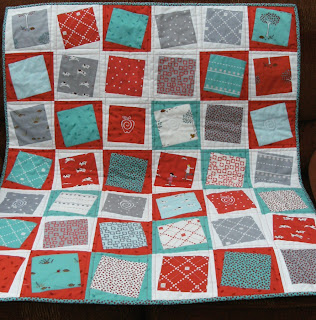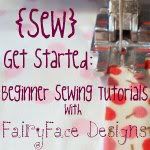Today I am really excited to introduce you to my friend Sheila! Sheila has a lovely blog at bluepatch quilter and is a very accomplished lady. She teaches classes in quilting in real life so I thought that it would be great to have her contribute a tutorial so we could benefit from all her knowledge! Sheila makes both modern and more traditional quilts and I love looking at her projects. This recent quilt with Little Apples is just gorgeous!
This tutorial is part of the {Sew} Get Started: Beginner Sewing Tutorials series. To go to the master page with a full list of tutorials and links to past tutes, please click on the link.
So, Sheila, it's over to you!
Hi everyone, my name is Sheila and I blog over at bluepatchquilter. Thank you Sarah, for asking me to contribute to your [Sew]Get Started series, I hope you are all enjoying it.
My project derives from Somerset Patchwork and doesn't involve a whole lot of sewing - this technique was something the Victorian ladies would do but my version includes a few up to date tricks.
These little pot stands are fun to put together and make good gifts. You can use them perhaps as a teapot stand or for placing a potted plant.
So - here is what you will need.
3 fat quarters, say one solid and two patterned.
Some fusible web, (you know, the sort folks use to take up their trousers when they don't want to sew.)
It is possible to use just 2 fat quarters but I have opted for three today to accommodate the smaller US fat 1/4 size and also to give a bit of contrast. I used my solid white piece for the foundation layer onto which we will build our mat, and for some of the folded pieces. I used a print for the other folded pieces, and then the second print for the borders and backing. There is no need to use any wadding/batting for this project as it is quite thick when finished.
Cut the solid fabric into - 1 x 9.5" square & 4 x 4" squares
1st print - Cut 8 x 4" squares
2nd print - Cut 4 strips, 2.5" x 10"
& 2 pieces, 5" x 10".
Fold and press the 9.5" square in half, in both directions.
Fold all of the 4" squares in half, diagonally & press. A bit of steam helps here, but watch your fingers!
This is the fusible web I mentioned, a little advantage we have over those Victorian ladies. Cut some small squares of web.
Next, we want to fold down the two outside corners of the folded squares, to meet the bottom corner.
And this is where I use the addition of a small square of fusible web, to hold down the sides.
Pop in the square of web, fold and press. Take your time here and concentrate on trying to achieve a neat folded point - this might be at the expense of the raw edges being a tad uneven, don't worry.
and repeat until all 12 squares have been folded and pressed. Now it's assembly time.
Place 4 of your print squares onto your foundation square. All the folded points come together in the centre and the folded edges will align with the creases in the large square. Now, on reflection, I think it would be a good idea to pop another square of fusible web under each quarter and lightly press.
Pin in place and then tack (baste) around the edges either by hand or by machine. To machine tack, choose as big a stitch length as your machine will allow.
The next layer will be the 4 solid squares. When you look at the four of these laid down as in the above pic, you can see they form a loose square together, but it has been set on point. All the folded points are still towards the centre, this time the centre folds of each little square aligns with the creases........now this is the stage where you have to do as I say and not as I did because you will see quite clearly that my left and right squares do NOT align too well. This has either been sloppy placement, or the squares moved when I machined them down. Once again, use a wee bit of fusible web to help you position, pin carefully and tack (baste) all round. If yours ends up a wee bit wonky like mine, never fear, it all adds a bit of character!!
Now, you might be forgiven for thinking you have morphed into a different tute, but when I was sorting and editing the photos I was gutted to find I had missed the third layer from the photo shoot!! Luckily I had an older version on file so I hope you will forgive me. The third layer returns to the 1st print and is placed in the same orientation as the first layer. You are aiming for even spacing and once again, use a bit of fusible web and some pins and tacking stitches to hold. We are now at the actual sewing stage!!
Take one of your 2.5" x 10" strips, lay it across your mat, aligning the top of one long edge with the edges of the last two squares you laid down. The strip should be right side down. Pin, and stitch along the long edge. If you have a walking foot, it might be useful to use it at this point as there is a bit of thickness to get through but I managed without. Take it slowly. These strips could have been cut to a more accurate length but cutting all four to 10" allows a bit of leeway, extra padding and room for squaring up later....The seam allowance can be whatever happens when you keep the edge of your foot to the edge of your seam.
Press the strip open and away from the centre.
Repeat for the opposite side. Press open, and away from the centre.
Repeat for the other two sides and give it all a good press, with steam. If you have revealed any of your tacking stitches, these can be carefully unpicked. Now it all looks a bit rough at this stage doesn't it? In previos mats, I have trimmed excess fabric before placing the strips but I think leaving them alone can be an advantage as the extra bulk is a good thing in a pot stand isn't it?
But, we do need to square this baby up.
I like to line up a vertical line on my ruler with the centre vertical line on the mat. I have carefully chosen my pink ruler so that you have difficulty seeing it in the photo!!
I started with the 4.5" line and adjusted until the right side edge could be trimmed neatly. It was 4" in the end. I then turned the mat so that this newly trimmed edge was at the bottom giving me a nice clean edge to trim from. I lined up the 4" vertical line on the vertical centre line of the mat but also lining up a horizontal line on the ruler with the cut edge. Trim. Now I have two trimmed edges running at right angles
.
Then, out came my 9.5" square up ruler and I positioned the bottom right corner of the mat onto the 8" marking on the ruler. Then I was able to trim the left side edge and the top edge. If you don't have a square up ruler you will be able to square up using the markings on your cutting mat.
Now to back this mat.....almost there.
Fuzzy picture alert!!
Place your backing pieces right sides together and sew along the long edge, using a 1/4" seam - leave a gap in the seam in the middle, of about 3".
Open and press seam to one side.
Now place your mat, right sides down onto the right side of the backing piece, position centrally, pin and then stitch all the way around the edge of the mat, using a 1/4" seam.(or thereabouts)
Trim all around and cut across the corners - see pic - being careful to avoid the stitching. This will result in lovely corners in a minute.......
Turn thro the opening in the back, I always think of this as the birthing moment. Use something pointy, like a chopstick, to poke out your corners. I can take wonky fronts, but I like a neat corner!
Hand stitch the opening to close.
Now it just needs a final press............
and a plant....
or a teapot!
I do hope you will try this.
Thanks so much Sheila for a great tutorial - I love this and think it would make a perfect pressie for my mum who has about a million pot plants in her house! If you make a pot holder, please add to the Flickr group :-) Don't forget that next week Sarah is doing a tutorial for a fabric wallet so pop back next Thursday for that.

.JPG)



.JPG)
.JPG)
.JPG)
.JPG)
.JPG)
.JPG)
.JPG)
.JPG)
.JPG)
.jpg)
.JPG)
.JPG)
.JPG)
.JPG)
.JPG)
.JPG)
.JPG)
.JPG)
.JPG)
.JPG)
.JPG)

21 comments:
That is absolutely gorgeous!
What a cool idea and love the design =D
Great tute from Sheila - thanks for sharing.
I love this tutorial Sheila. Thank you!!
I LOVE this pot holder and have to make one!! Thanks for the tutorial!
This is beautiful!!!!!! Thanks for sharing.
These look like fun and are pretty too. Thank you for the tutorial.
Very cute! I love the bright fabric.
Lovely and a wonderful tutorial.
Thanks everyone, it was my pleasure.
Thanks Sheila!
I wished I lived nearer!!!
I am so going to try this!I want a bigger one so would it be ok to double the measurements? Thanks Sheila!
These can indeed be made bigger - experiment with bigger squares. When you make a bigger mat it is an idea to either do a little top stitching or a few hand stitches here and there just to stop it gaping.
Great idea - have done a star shape with this idea - cannot remember how now but think I started with rectangles!??
Great tute Sheila (there was me getting my 'no cooking' excuses ready, and you put a plant on it!) xxx
Thanks Sarah for hosting such a great tutorial by Sheila. Di xo
How cool, kind of square cathedral windows...
Very clear tutorial. And love the 'different' fabric in the middle. Thanks Sarah and Sheila.
What a cheerful pot stand and a very clear tutorial with lots of photos to follow along.
Love the pot stand. It looks wonderful and looks like something I could actually make......
Love the pot stand. It looks wonderful and looks like something I could actually make......
Post a Comment